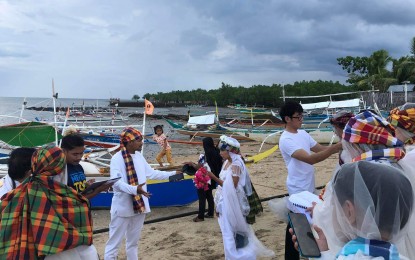
MANGROVE ISLAND. One of the scenes of “Amon Banwa sa Lawod” (Our Island of the Mangrove Moon) being shot in Suyac Island of Sagay City, Negros Occidental. The international full-length film is helmed by acclaimed Filipino director Anton Juan. (Photo courtesy of Sagay City Information and Tourism Office)
BACOLOD CITY – The mangrove island of Suyac in Sagay City, Negros Occidental is showcased in an international full-length film helmed by acclaimed Filipino director Anton Juan.
Titled “Amon Banwa sa Lawod” (Our Island of the Mangrove Moon), the movie was shot for 10 days between April and May this year.
“The film would articulate the mangrove community, resurrect the lives of the people living and dead, their struggles and simple joys, their resilience, and connection with the environment, and their relationship with the sea and their protection of their mangrove island,” Juan said in his director’s statement.
He noted that all these sustain the community as a source of food, economic survival, and protection from huge flooding in the typhoon and monsoon seasons.
The film was shot with the permission and participation of the locals, including fisherfolk, children, and island people, who served as spot and supporting actors.
Actors from Sagay and Bacolod, most of them acting for the first time, starred in the “Amon Banwa sa Lawod”.
Written by Juan and award-winning Sagaynon filmmaker Mark Garcia, who also served as an assistant director, the film, devised from the play “Our Town” by Thornton Wilder, revolves around the memories of the island centered on the life, love, and passing of the people.
“The central dramatic line grows from the everyday resilience of fisherfolk, living by hope, work, and faith, confronting a global problem: the erasure of a people’s historical existence by power structures and neo-colonial moves on the high seas,” Juan said.
“I thank the city government of Sagay and Mayor Alfredo Marañon III for helping create a film that will speak of our people's beauty. In these crucial times we need to consolidate creative forces,” he added.
Garcia said Juan had been planning to shoot in Suyac Island even before the pandemic.
“It was a dream come true for him as the discussion to pursue the production happened again in December last year. We had to discuss most of the preparations online, including the script. The story was devised from a play, but the script was all inspired by the island, its people, and their ways of life,” he added.
“Amon Banwa sa Lawod”, produced by the US-based Kellogg Institute for International Studies, Erehwon Center for the Arts, the Performance Laboratory, Negros Cultural Foundation, The Negros Museum, and the City Government of Sagay, is set to hold an international premiere next year and will have local screenings in Suyac Island, Sagay City proper, and The Negros Museum here.
Marañon, who is outgoing mayor and congressman-elect of Negros Occidental’s second district, said the city government supports the creative undertaking with the belief that film is powerful and persuasive.
“Film has also the potential to promote to tourism and with the strong local filmmaking movement, we can collaborate and make Sagay a film tourism destination in Negros provided that it will be environment and community-friendly, respecting the culture and sensibilities of our people,” he added. (PNA)
